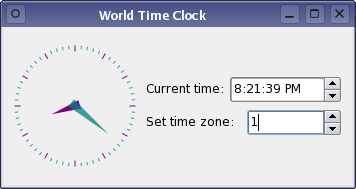- Accueil Actualités IT Pro
- Conception Cycle de vie du logiciel
- Java Plateforme et langage Java
- .NET Microsoft Framework .NET
- Dév. Web Développement Web et Webmarketing
- EDI Environnements de Développement Intégré
- Langages Langages de programmation applicatifs
- SGBD Systèmes de Gestion de Bases de Données
- Office Bureautique pour l'entreprise
- Solutions d'entreprise Autres logiciels pour l'entreprise
- Applications Applications logicielles
- Systèmes Logiciels et matériels systèmes
World Time Clock Builder ExampleFiles:
The World Time Clock Builder example shows how forms created with Qt Designer that contain custom widgets can be dynamically generated at run-time.
This example uses a form containing the custom widget plugin described in the World Time Clock Plugin example, and dynamically generates a user interface using the QUiLoader class, part of the QtUiTools module. PreparationAs with the Calculator Builder example, the project file for this example needs to include the appropriate definitions to ensure that it is built against the required Qt modules. CONFIG += uitools SOURCES = main.cpp RESOURCES = worldtimeclockbuilder.qrc By appending form to the CONFIG declaration, we instruct qmake to generate a dependency on the libQtUiTools library containing the QtUiTools classes. Note that we do not inform qmake about any UI files, and so none will be processed and built into the application. The resource file contains an entry for the particular form that we wish to use: <!DOCTYPE RCC><RCC version="1.0">
<qresource prefix="/forms">
<file>form.ui</file>
</qresource>
</RCC>
Forms do not need to be included with the application in this way. We only include a form in the application's resources for convenience, and to keep the example short. Loading and Building the FormSince this example only loads and displays a pre-prepared form, all of the work can be done in the main() function. We are using a class from the QtUiTools library so, in addition to any other Qt classes that are normally required to write an application, we must include the appropriate header file: #include <QtUiTools>
The main function initializes the resource system with the Q_INIT_RESOURCE() macro and constructs an QApplication instance in the usual way: int main(int argc, char *argv[]) { Q_INIT_RESOURCE(worldtimeclockbuilder); QApplication app(argc, argv); QUiLoader loader; We construct a QUiLoader object to handle the form we want to use. The form itself is obtained from the resource file system using the path defined in the resource file. We use the form loader to load and construct the form: QFile file(":/forms/form.ui"); file.open(QFile::ReadOnly); QWidget *widget = loader.load(&file); file.close(); widget->show(); Once the form has been loaded, the resource file can be closed and the widget is shown. return app.exec(); } The form loader ensures that all the signal and slot connections between objects in the form are set up correctly when the form is loaded. As a result, the time is updated by the World Time Clock widget, and the time zone spin box can be used to change the position of the hour hand. © 2008-2011 Nokia Corporation and/or its subsidiaries. Nokia, Qt and their respective logos are trademarks of Nokia Corporation in Finland and/or other countries worldwide. All other trademarks are property of their respective owners. Privacy Policy Licensees holding valid Qt Commercial licenses may use this document in accordance with the Qt Commercial License Agreement provided with the Software or, alternatively, in accordance with the terms contained in a written agreement between you and Nokia. Alternatively, this document may be used under the terms of the GNU Free Documentation License version 1.3 as published by the Free Software Foundation. |




















